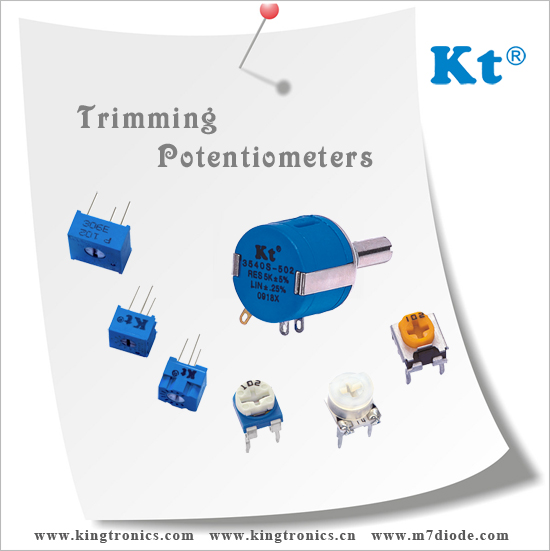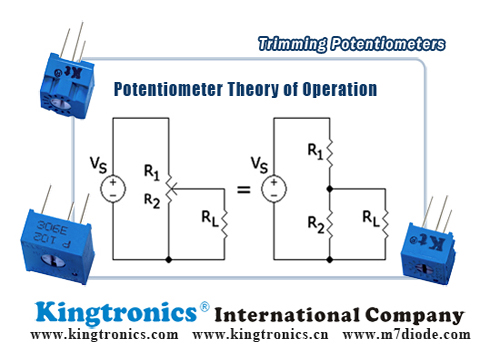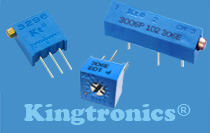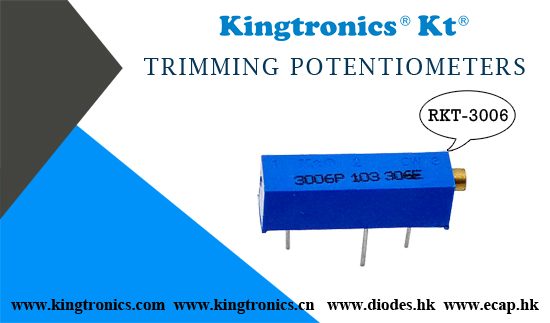Transducers
Potentiometers are also very widely used as a part of displacement transducers because of the simplicity of construction and because they can give a large output signal.
Computation
In analog computers, high precision potentiometers are used to scale intermediate results by desired constant factors, or to set initial conditions for a calculation. A motor-driven potentiometer may be used as a function generator, using a non-linear resistance card to supply approximations to trigonometric functions. For example, the shaft rotation might represent an angle, and the voltage division ratio can be made proportional to the cosine of the angle.
- 0Commentary
- Tags:
Kingtronics About Trimming Potentiometers
25 Feb 2011Variable resistors used as potentiometers have all three terminals connected.

This arrangement is normally used to vary voltage, for example to set the switching point of a circuit with a sensor, or control the volume (loudness) in an amplifier circuit. If the terminals at the ends of the track are connected across the power supply then the wiper terminal will provide a voltage which can be varied from zero up to the maximum of the supply.
- 0Commentary
- Tags:
Kingtronics Trimming Potentiometer
12 Feb 2011Kingtronics is a manufacturer of Trimming Potentiometer. Trimming potentiometers are Kingtronics' first products. On Kingtronics' trimming potentiometers body, we mark "King" due to insufficient space. “Kingtronics” and "Kt" are our brand too. So, Kingtronics trimmers, Kingtronics potentiometers, King trimmers, and King potentiometers all mean potentiometers which produced by Kingtronics International Company.Our products are well crossed to Bourns Brand parts. We offer Kingtronics potentiometers (with Kt Mark trimming potentiometer) include following part number: RKT-3006, RKT-3266, RKT-3296, RKT-3299, RKT-3323, RKT-3329, RKT-3362, RKT-3386, RKT-3318, RKT-3306, RKT-3309, RKT-065, RKT-105H, RKT-C3305, RKT-3361, RKT-3540S, RKT-3590. Our trimming potentiometers are RoHS compliant.
Now Kingtronics offer Bourns equivalence. If you want more details , please visit website:www.kingtronics.com for full specification.
If you have any inquiry about Trimming Potentiometer , pls contact info@kingtronics.com.
Welcome to check our price!
- 0Commentary
- Tags:
The reliability of a potentiometer depends on its ability to continue performing its intended function. Since the primary function is to provide a continuous and proportional voltage output, the primary reliability considerations are continuity and proportional voltage output. A failure in continuity is always catastrophic, as the device is no longer acting as a potentiometer.
The primary constituents of continuity are:
Wiper contact to conductive surface
Continuous conductive surface
Wiper (output) and excitation terminal continuity

Dielectric Voltage Ratings of Potentiometer
15 Jan 2011Dielectric Voltage - The dielectric (insulation of Potentiometer "guts" to the body) rating is especially important if the Potentiometer is connected to mains operated, non-isolated equipment. Wall mounted lamp dimmers and such are typical examples. This is not commonly specified, but for safety, should be at least 2.5kV. A common way to achieve this is to use a plastic shaft, with the body of the Potentiometer insulated from the chassis, and inaccessible by the user - even if the knob falls off or is removed! This point cannot be stressed highly enough.
Most standard Potentiometer will safely withstand (maybe) 100V or so between the resistance element and terminals, and the body and shaft. Miniature types will usually be less than this. Never, ever, use a standard Potentiometer with a metal shaft to control direct mains operated equipment. Even if the Potentiometer case is earthed, the voltage rating between the internal element(s) and terminals to the case is often unspecified, and is almost always completely unsuited to mains voltages.
- 0Commentary
- Tags:
The potentiometer can be used as a voltage divider to obtain a manually adjustable output voltage at the slider (wiper) from a fixed input voltage applied across the two ends of the potentiometer. This is the most common use of them.
If RL is large compared to the other resistances (like the input to an operational amplifier), the output voltage can be approximated by the simpler equation:
As an example, assume
 ,
,  ,
,  , and
, and 
Since the load resistance is large compared to the other resistances, the output voltage VL will be approximately:
Due to the load resistance, however, it will actually be slightly lower: ≈ 6.623 V.
One of the advantages of the potential divider compared to a variable resistor in series with the source is that, while variable resistors have a maximum resistance where some current will always flow, dividers are able to vary the output voltage from maximum (VS) to ground (zero volts) as the wiper moves from one end of the potentiometer to the other. There is, however, always a small amount of contact resistance.
In addition, the load resistance is often not known and therefore simply placing a variable resistor in series with the load could have a negligible effect or an excessive effect, depending on the load.
Kingtronics trimming potentiometer 3006, 3266, 3296, 3323, 3329, 3362, 3386,3309, 3540, 3590 ("King Mark")
25 Dec 2010A trimmer or preset[1] is a miniature adjustable electrical component. It is meant to be set correctly when installed in some device, and never seen or adjusted by the device's user. Trimmers can be variable resistors (potentiometers), variable capacitors, trimmable inductors. They are common in precision circuitry like A/V components, and may need to be adjusted when the equipment is serviced. Unlike many other variable controls, trimmers are mounted directly on circuit boards, turned with a small screwdriver and rated for many fewer adjustments over their lifetime. Trimmers like trimmable inductors and trimmable capacitors are usually found in superhet radio and television receivers, in the Intermediate frequency, oscillator and RF circuits. They are adjusted into the right position during the alignment procedure of the receiver.
Trimmers come in a variety of sizes and levels of precision; for example, multi-turn trim potentiometers exist, in which it takes several turns of the adjustment screw to reach the end value, allowing for very high degrees of accuracy.
Since 1990 , Kingtronics International company founded its first factory in mainland of China . For 20 years development and experience in manufacturing timpots , Kingtronics brand is well known by more and more pepole .
Now Kingtronics offer Bourns equivalence: 3006, 3266, 3296, 3323, 3329, 3362, 3386,3309, 3540, 3590 . If you want more details ,please visit website: www.kingtronics.com for full specification.

- 0Commentary
- Tags:
Trimming Potentiometer introduction
22 Dec 2010There are Trimming Potentiometer (aka trimmers) - pots designed for "set and forget" applications. They are used for "trimming" the value of a resistor, and are commonly used for calibrating instruments, setting the bias current on power amplifiers, and a host of other areas where a circuit cannot be relied upon to give an exact gain, output voltage, or current. Naturally, a normal panel pot can be used, but these are very much bigger, and any calibration or setup control should not be made available for everyone to fiddle with as they please.

This is a very small sample of those available. The first and fourth are multi-turn types, and these should be used when a very precise setting is required. Because they are sealed, they are relatively immune from contamination, and for all but the most trivial application, should be used instead of the open types. Trimming Potentiometer(as shown) are generally available as vertical or horizontal - the choice is usually made based on ease of adjustment of the final circuit.
- 0Commentary
- Tags:
Potentiometers
7 Dec 2010A common element in electronic devices is a three-terminal resistor with a continuously adjustable tapping point controlled by rotation of a shaft or a knob. These variable resistors are known as potentiometers when all three terminals are present, since they act as a continuously adjustable voltage divider. A common example is a volume control for a radio receiver.
Accurate, high-resolution panel-mounted potentiometers (or "pots") have resistance elements typically wirewound on a helical mandrel, although some include a conductive-plastic resistance coating over the wire to improve resolution. These typically offer ten turns of their shafts to cover their full range. They are usually set with dials that include a simple turns counter and a graduated dial. Electronic analog computers used them in quantity for setting coefficients, and delayed-sweep oscilloscopes of recent decades included one on their panels.
- 0Commentary
- Tags:
Variable resistors used as potentiometers have all three terminals connected. This arrangement is normally used to vary voltage, for example to set the switching point of a circuit with a sensor, or control the volume (loudness) in an amplifier circuit. If the terminals at the ends of the track are connected across the power supply then the wiper terminal will provide a voltage which can be varied from zero up to the maximum of the supply.
Kingtronics are potentiometers manufacturer since 1990. Trimming potentiometers are Kingtronics' first products. RKT-3006 is one of the Trimming potentiometers,It is used where very precise adjustments must be made.RKT-3006 has 3 terminal styles:3006W, 3006P, 3006Y. The screw must be turned many times (10+) to move the slider from one end of the track to the other, giving very fine control.

Contact us
Tel: (86) 769 8118 8110
Tel: (852) 8106 7033
Fax: (852) 8106 7099
E-mail: info@kingtronics.com
Skype: kingtronics.sales
MSN: kingtronics-sales@hotmail.com
Web: www.Kingtronics.com
YouTube: www.youtube.com/c/Kingtronicskt
About
Kingtronics International Company was established in 1995 located in Dongguan City of China to handle all sales & marketing for factories located in Chengdu, Sichuan and Zhaoqing, Guangdong, China. In 1990, we established the first factory to produce trimming potentiometer and in 1999 we built up new factory in Zhao Qing, Guangdong. Now with around 850 workers, Kingtronics produce trimming potentiometers, dipped tantalum capacitors, multilayer ceramic capacitors, and diode & bridge rectifier. We sell good quality under our brand Kingtronics, and Kt, King, Kingtronics are our three trademarks. All our products are RoHS compliant, and our bridge rectifier have UL approval. Please visit our Products page, you could please download all our PDF datasheet and find cross reference for our Trimming Potentiometer and capacitors.
Tantalum and Ceramic Capacitors Cross Reference ↓ Download
Diodes & Rectifiers List(PDF: 97KB) ↓ Download
Trimming Potentiometer Cross Reference ↓Download
Categories
- Kt Kingtronics (245)
- Diodes & Rectifiers (159)
- Aluminum Electrolytic Capacitor (149)
- Trimming Potentiometers (123)
- Tantalum Capacitors (94)
- Multilayer Ceramic Capacitors (70)
- Kt Bridge Rectifier (64)
- Quartz Crystals (58)
- Surge Arresters (34)
- Tactile Switches (32)
- Kt Kingtronics Components (30)
- Ceramic Trimmer Capacitors (25)
- Film Capacitors (23)
- Super Capacitors (17)
- Metal Oxide Varistor (10)
- Negative Temperature Coefficient Thermistor (6)
- Music capacitors (2)
Archives
- 2024 April (2)
- 2024 March (2)
- 2024 February (2)
- 2024 January (3)
- 2023 December (1)
- 2023 November (2)
- 2023 October (1)
- 2023 September (2)
- 2023 August (2)
- 2023 July (4)
- 2023 June (12)
- 2023 May (6)
- 2023 April (4)
- 2023 March (3)
- 2023 February (2)
- 2023 January (1)
- 2022 December (3)
- 2022 November (2)
- 2022 October (3)
- 2022 September (4)
- 2022 August (3)
- 2022 July (3)
- 2022 June (2)
- 2022 May (3)
- 2022 April (4)
- 2022 March (4)
- 2022 February (2)
- 2022 January (3)
- 2021 December (4)
- 2021 November (3)
- 2021 October (4)
- 2021 September (4)
- 2021 August (4)
- 2021 July (4)
- 2021 June (5)
- 2021 May (4)
- 2021 April (3)
- 2021 March (4)
- 2021 February (4)
- 2021 January (4)
- 2020 December (5)
- 2020 November (4)
- 2020 October (4)
- 2020 September (7)
- 2020 August (8)
- 2020 July (9)
- 2020 June (8)
- 2020 May (9)
- 2020 April (11)
- 2020 March (6)
- 2020 February (4)
- 2020 January (4)
- 2019 December (6)
- 2019 November (7)
- 2019 October (6)
- 2019 September (5)
- 2019 August (9)
- 2019 July (6)
- 2019 June (4)
- 2019 May (16)
- 2019 April (6)
- 2019 March (6)
- 2019 February (9)
- 2019 January (5)
- 2018 December (4)
- 2018 November (4)
- 2018 October (5)
- 2018 September (8)
- 2018 August (10)
- 2018 July (7)
- 2018 June (12)
- 2018 May (22)
- 2018 April (4)
- 2018 March (4)
- 2018 February (8)
- 2018 January (13)
- 2017 December (4)
- 2017 November (4)
- 2017 October (5)
- 2017 September (4)
- 2017 August (21)
- 2017 July (7)
- 2017 June (5)
- 2017 May (4)
- 2017 April (4)
- 2017 March (9)
- 2017 February (8)
- 2017 January (8)
- 2016 December (10)
- 2016 November (16)
- 2016 October (8)
- 2016 September (10)
- 2016 August (13)
- 2016 July (12)
- 2016 June (10)
- 2016 May (14)
- 2016 April (8)
- 2016 March (10)
- 2016 February (6)
- 2016 January (8)
- 2015 December (10)
- 2015 November (8)
- 2015 October (3)
- 2015 July (5)
- 2015 June (9)
- 2015 May (7)
- 2015 April (8)
- 2015 March (9)
- 2015 February (7)
- 2015 January (5)
- 2014 December (13)
- 2014 November (4)
- 2014 October (4)
- 2014 September (5)
- 2014 August (4)
- 2014 July (4)
- 2014 June (4)
- 2014 May (4)
- 2014 April (4)
- 2014 March (5)
- 2014 February (3)
- 2014 January (4)
- 2013 December (8)
- 2013 November (9)
- 2013 October (10)
- 2013 September (9)
- 2013 August (11)
- 2013 July (10)
- 2013 June (3)
- 2013 May (4)
- 2013 April (5)
- 2013 March (2)
- 2013 February (1)
- 2013 January (3)
- 2012 December (5)
- 2012 November (6)
- 2012 October (5)
- 2012 September (10)
- 2012 August (11)
- 2012 July (11)
- 2012 June (12)
- 2012 May (14)
- 2012 April (10)
- 2012 March (14)
- 2012 February (10)
- 2012 January (6)
- 2011 December (9)
- 2011 November (11)
- 2011 October (10)
- 2011 September (13)
- 2011 August (14)
- 2011 July (13)
- 2011 June (13)
- 2011 May (13)
- 2011 April (14)
- 2011 March (27)
- 2011 February (13)
- 2011 January (24)
- 2010 December (21)
- 2010 November (12)
- 2010 October (11)



